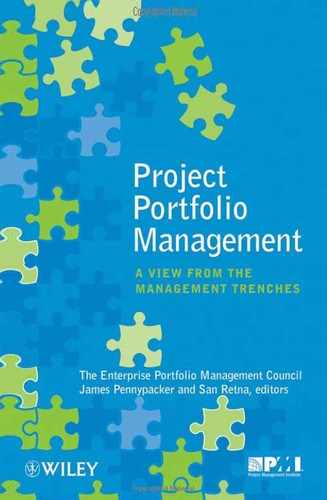1.4. PROJECT PORTFOLIO MANAGEMENT DEFINED
Okay, enough with the questions. So just what is project portfolio management? Rather than reinvent the wheel, we'll draw on what exists in the literature today for a succinct definition (Project Management Institute, 2006):
The centralized management one or more portfolios, which includes identifying, prioritizing, authorizing, managing, and controlling projects, programs, and other related work to achieve specific strategic business objectives.
PPM accomplishes its purpose by adhering to some fundamental actions. PPM:
Ensures that projects and programs align with the strategies, goals, and objectives of the business
Communicates project and program details, including costs and benefits
Manages projects and programs as a whole, providing a holistic, systems approach to business projects
Foundational PrinciplePPM ensures the alignment of projects with strategies, communicates project details, and manages projects holistically. |
Now wait a minute, you say. You've heard about portfolios, but have you heard about the different types of portfolios that can be found in business? And how are they different? Quite simply, from a management perspective, they aren't different. The bottom line is that it's all about effectively managing the work a business is doing that costs money with an eye toward fulfilling the strategic goals and bringing financial and nonfinancial benefits to the company.
The following are some of the many variations on the theme of portfolio management found throughout organizations today:
Project Portfolio Management (naturally!)
Application Portfolio Management
Product Portfolio Management
IT Portfolio Management
Asset Portfolio Management
Enterprise Portfolio Management
Investment Portfolio Management
Investment Management
Resource Portfolio Management
Options Management
Pipeline Management
Software Portfolio Management
Governance Process
PPM is about action, so that's what we'll focus on. This book will not delve into how business strategies are developed. There are plenty of books and articles to help you do that. PPM acknowledges that strategy development is not just a linear process, and that strategy makers need feedback on how the strategy is working. This is one of the critical roles of PPM. By informing strategy makers, PPM makes strategy development and maintenance a more interactive process.
Foundational PrinciplePPM is about action. |
In performing its role in capacity management, PPM provides information on resource allocation and its impact and affect on strategy and the other projects in the portfolio.
As mentioned before, implementation of PPM is not easy. We hope this book will help the reader to identify blind spots when attempting to implement PPM through the authors' sharing the lessons we have learned through the school of hard knocks. This book will not go into the detail of planning a project, but should provide some critical success factors (our "aha" moments) to effectively implement PPM.
